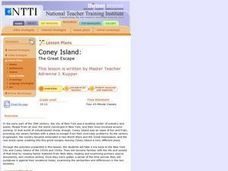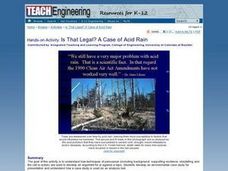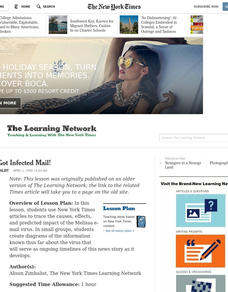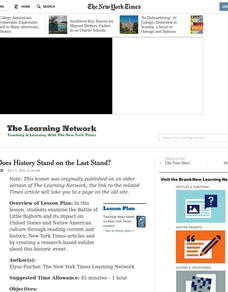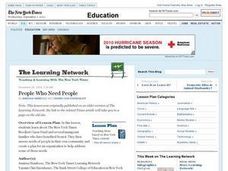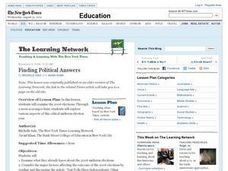Curated OER
New York Times
Students explore current events. In this cross-curriculum lesson, students read and answer questions about the various articles included in the magazine.
Curated OER
Time in a Capsule
Students analyze the meaning and process of categorizing items, people and events as 'the best.' students then defend pieces of literature, images, and sounds that they feel most represent 'the best of the 20th century.'
National Endowment for the Humanities
African-American Communities in the North Before the Civil War
Middle schoolers may be surprised to learn that before the American Civil War there were more slaves living in New York than there were in Kentucky! Young historians examine maps and census data to gather statistics about...
Curated OER
DNA Fingerprinting
Students discuss methods used by forensic scientists and the basics of DNA and how it can be used to identify an individual after reading an article from The New York Times.
Curated OER
Relative Dating-Telling Time Using Fossils
Students explore how to read fossil range charts. They develop an knowledge of the strengths and weaknesses of the fossil record. Students become familiar with the concepts index fossil and fossil range. Students use bar graphs to...
Curated OER
Coney Island: The Great Escape
Students use primary documents and film to explore the role of Coney Island recreation for New Yorker's at the beginning of the 20th century. They compare the lives of the people in their research to their own.
Rockefeller Archive Center
Understanding Mass Media News
In an age of fake news and photoshopped images, it is vital that 21st century learners development the skills they need to evaluate mass media and assess its validity. A great way to launch such a study is with a carefully crafted lesson...
Curated OER
A New Era for Palestinians
Get a global perspective and examine the challenges facing Mahmoud Abbas, the newly elected president of the Palestinian Authority. Thoughtful classroom citizens write letters to Mr. Abbas, asking him questions and suggesting advice....
Curated OER
Is That Legal? A Case of Acid Rain
Develop an environmental case study! Elementary learners discover how a case study is used as an analysis tool. The goal of this activity is to show pupils how techniques of persuasion (including background, supporting evidence,...
Curated OER
Justice For All?
Students study about President Bush's nomination of federal appeals court judge John G. Roberts to the Supreme Court. They compare coverage of the nomination in different sections and articles in The New York Times.
Curated OER
The Primary Issue
Students analyze the 2008 presidential primaries by reading and discussing the New York Times Upfront article "Primary Matters." They complete a KWL chart, complete a handout, read the article and answer comprehension questions, and...
Curated OER
You've Got Infected Mail!
Students use New York Times articles to trace the causes, effects, and predicted impact of the Melissa e-mail virus. In small groups, students create diagrams of the information about the virus that serves as ongoing timelines of this...
Curated OER
Separate But Equal Opinions
High schoolers examine the ways in which editorials and Op-Ed pieces respond to current events. They write editorials in response to news items from the New York Times.
Curated OER
Where Does History Stand on the Last Stand?
Students examine the Battle of Little Bighorn and its impact on United States and Native American culture through reading current and historic New York Times articles and by creating a research-based exhibit about this historic event.
Curated OER
Reviews Revealed
Students discuss the benefits or drawbacks in consulting movie reviews. They analyze movie reviews from The New York Times and create a list of features in effective movie reviews. They write their own movie reviews based on this list.
Curated OER
People Who Need People
Students study The New York Times Neediest Cases Fund and several immigrant families who have benefited from it. They assess needs of people in their own community and create a plan for an organization to help address some of those needs.
Curated OER
All for One, and One for Oil?
Students explore the way the oil market both informs and complicates international diplomacy. They examine the relationships between and among some of the world's leading oil producers using a graphic feature from The New York Times as a...
Curated OER
Finding Political Answers
Students discuss the 2006 midterm elections. They read an article about exit polls. They create a scavenger hunt using articles of the New York Times. They write a paper about the importance of midterm elections.
Curated OER
Graphic Accounts
Learners identify the use of different types of bar graphs. They analyze graphs used in the New York Times to compare the estimated cost of the war in Iraq to other hypothetical expenditures and reflect on how graphs can help illustrate...
Curated OER
The Reader's Recourse
Students discover the recourse newspapers face for reporting wrong information. After reading an article, they examine the dispute between a pharmaceutical company and the New York Times. They evaluate the roles of the editor and the...
Curated OER
High Profiles
Students research and write newspaper articles about current world leaders, using a New York Times International article as a model. They research a current world leader's personal background and political history.
Curated OER
Walking in Other People's Shoes
Students study the story of student journalist Casey Parks' September, 2006, journey to Central Africa with New York Times columnist, Nicholas Kristof. They then act as representatives to the tourism boards of developing countries and...
Curated OER
Ho Ho Poetry
Students read about the sights and sounds of a Las Vegas Christmas. They use words and phrases taken from articles in a recent issue of the New York Times to create a holiday-themed "found Poem."
Curated OER
Stranger Than Fiction
Students reflect on the importance of science literacy. They review the year's science curriculum by reading, discussing and writing questions on teacher-selected New York Times articles and the related science content.







